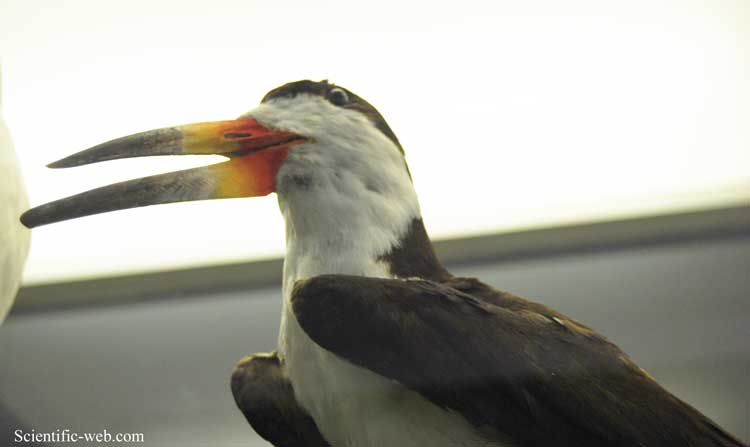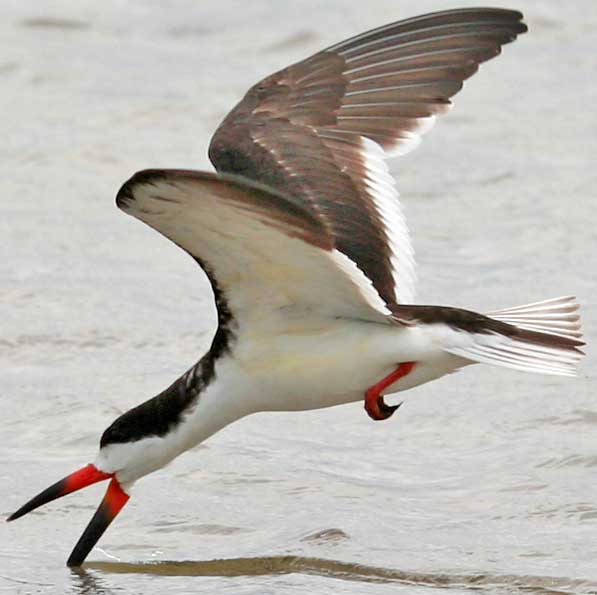
Rynchops niger , Photo: Michael Lahanas
Superregnum: Eukaryota
Cladus: Unikonta
Cladus: Opisthokonta
Cladus: Holozoa
Regnum: Animalia
Subregnum: Eumetazoa
Cladus: Bilateria
Cladus: Nephrozoa
Superphylum: Deuterostomia
Phylum: Chordata
Subphylum: Vertebrata
Infraphylum: Gnathostomata
Megaclassis: Osteichthyes
Cladus: Sarcopterygii
Cladus: Rhipidistia
Cladus: Tetrapodomorpha
Cladus: Eotetrapodiformes
Cladus: Elpistostegalia
Superclassis: Tetrapoda
Cladus: Reptiliomorpha
Cladus: Amniota
Classis: Reptilia
Cladus: Eureptilia
Cladus: Romeriida
Subclassis: Diapsida
Cladus: Sauria
Infraclassis: Archosauromorpha
Cladus: Crurotarsi
Divisio: Archosauria
Cladus: Avemetatarsalia
Cladus: Ornithodira
Subtaxon: Dinosauromorpha
Cladus: Dinosauriformes
Cladus: Dracohors
Cladus: Dinosauria
Ordo: Saurischia
Cladus: Eusaurischia
Subordo: Theropoda
Cladus: Neotheropoda
Cladus: Averostra
Cladus: Tetanurae
Cladus: Avetheropoda
Cladus: Coelurosauria
Cladus: Tyrannoraptora
Cladus: Maniraptoromorpha
Cladus: Maniraptoriformes
Cladus: Maniraptora
Cladus: Pennaraptora
Cladus: Paraves
Cladus: Eumaniraptora
Cladus: Avialae
Infraclassis: Aves
Cladus: Euavialae
Cladus: Avebrevicauda
Cladus: Pygostylia
Cladus: Ornithothoraces
Cladus: Ornithuromorpha
Cladus: Carinatae
Parvclassis: Neornithes
Cohors: Neognathae
Cladus: Neoaves
Ordo: Charadriiformes
Subordo: Lari
Familia: Rynchopidae
Genus: Rynchops
Species: Rynchops niger
Subspecies: R. n. cinerascens – R. n. intercedens – R. n. niger
Name
Rynchops niger Linnaeus, 1758
Original combination: Rynchops nigra
Synonyms
Rynchops fulva Linnaeus, 1758

Rynchops niger (*)
References
Linnaeus, C. 1758. Systema Naturae per regna tria naturae, secundum classes, ordines, genera, species, cum characteribus, differentiis, synonymis, locis. Editio Decima, Reformata. Tomus I. Holmiæ (Stockholm): impensis direct. Laurentii Salvii. 824 pp. DOI: 10.5962/bhl.title.542 BHL p. 138 BHL Reference page.
IUCN: Rynchops niger (Least Concern)
Vernacular names
català: Bec de tisora negre
čeština: zoboun americký
dansk: Amerikansk Saksnæb
Deutsch: Amerikanischer Scherenschnabel, Schwarzmantel-Scherenschnabel
English: Black Skimmer, American Skimmer
Esperanto: Nigra tondilbekulo
español: Rayador americano
eesti: ameerika käärnokk
suomi: amerikansaksinokka
français: Bec-en-ciseaux noir
Avañe'ẽ: Pa'â guasu
Kreyòl ayisyen: Bèk sizo
magyar: karibi ollóscsőrű, kormos ollóscsőrű madár
italiano: Becco a cesoie americano
日本語: クロハサミアジサシ, kurohasamiajisashi
Nederlands: Amerikaanse schaarbek
norsk: Amerikasaksenebb
polski: Brzytwodziób amerykański
português do Brasil: Talha-mar
português: Talha-mar, corta-água
русский: Чёрный водорез
slovenčina: zobáľ čiernochrbtý
svenska: Amerikansk saxnäbb
Türkçe: Kara makasgaga
中文: 黑剪嘴鸥
The black skimmer (Rynchops niger) is a tern-like seabird, one of three similar birds species in the skimmer genus Rynchops in the gull family Laridae. It breeds in North and South America. Northern populations winter in the warmer waters of the Caribbean and the tropical and subtropical Pacific coasts, but the South American races make only shorter movements in response to annual floods which extend their feeding areas in the river shallows.
Taxonomy
The black skimmer was described by the Swedish naturalist Carl Linnaeus in 1755 in the tenth edition of his Systema Naturae and given the binomial name Rynchops niger.[2] The genus name Rynchops is from the Ancient Greek ῥυγχος/rhunkhos meaning "bill" and κοπτω/koptō meaning "to cut off". The specific niger is the Latin word for "black".[3] The black skimmer is one of three species in the genus Rynchops.[4]
There are three subspecies:[4]
R. n. niger (Linnaeus, 1758) – migratory, breeds on the Atlantic coast of North America, and from southern California to Ecuador in the Pacific
R. n. cinerascens (von Spix, 1825) – is larger, has dusky underwings, only narrow white fringe to its black tail, and breeds in northern and northeastern South America and the Amazon basin
R. n. intercedens (Saunders, 1895) – occurs on the rest of the Atlantic coast of South America south to central Argentina
Description
The black skimmer is the largest of the three skimmer species. It measures 40–50 cm (16–20 in) long with a 107–127 cm (42–50 in) wingspan.[5] This species ranges from 212 to 447 g (7.5 to 15.8 oz), with males averaging about 349 g (12.3 oz), as compared to the smaller females 254 g (9.0 oz).[6] The basal half of the bill is red, the rest mainly black, and the lower mandible is much-elongated. The eye has a dark brown iris and catlike vertical pupil, unique for a bird. The legs are red. The call is a barking kak-kak-kak.[7]
Adults in breeding plumage have a black crown, nape and upper body. The forehead and underparts are white. The upper wings are black with white on the rear edge, and the tail and rump are dark grey with white edges. The underwing colour varies from white to dusky grey depending on region.[7]
Non-breeding adults have paler and browner upperparts, and a white nape collar. Immature birds have brown upperparts with white feather tips and fringes. The underparts and forehead are white, and the underwings as the adult.[7]
Behaviour and ecology
Skimmers loafing gregariously on a sandbar. Skimmers will often lie flat on the ground.
feeding in water, Texas
Feeding, Brazil
They spend much time loafing gregariously on sandbars in the rivers, coasts and lagoons they frequent.
Breeding
The black skimmer breeds in loose groups on sandbanks and sandy beaches in the Americas, the three to seven heavily dark-blotched buff or bluish eggs being incubated by both the male and female. The chicks leave the nest as soon as they hatch and lie inconspicuously in the nest depression or "scrape" where they are shaded from high temperatures by the parents. They may dig their own depressions in the sand at times. Parents feed the young almost exclusively during the day with almost no feeding occurring at night, due to the entire population of adults sometimes departing the colony to forage. Although the mandibles are of equal length at hatching, they rapidly become unequal during fledging.[8]
Feeding
Skimmers have a light graceful flight, with steady beats of their long wings. They usually feed in large flocks, flying low over the water surface with the lower mandible skimming the water for (in order of importance) small fish, insects, crustaceans and molluscs[9] caught by touch by day or especially at night.[8] Fish species eaten include Odontesthes argentinenesis, Brevoortia aurea, Anchoa marinii, Lycengraulis grossidens, Engraulis anchoita, Pomatomus saltatrix, Mugil cephalus, Fundulus heteroclitus and Anchoa mitchelli.[10]
Development
Notes
BirdLife International (2016). "Rynchops niger". IUCN Red List of Threatened Species. 2016: e.T22694256A93442996. doi:10.2305/IUCN.UK.2016-3.RLTS.T22694256A93442996.en. Retrieved 12 November 2021.
Linnaeus, Carl (1758). Systema Naturae per regna tria naturae, secundum classes, ordines, genera, species, cum characteribus, differentiis, synonymis, locis (in Latin). Vol. 1 (10th ed.). Holmiae:Laurentii Salvii. p. 138.
Jobling, James A. (2010). The Helm Dictionary of Scientific Bird Names. London: Christopher Helm. pp. 270, 344. ISBN 978-1-4081-2501-4.
Gill, Frank; Donsker, David, eds. (2019). "Noddies, gulls, terns, auks". World Bird List Version 9.2. International Ornithologists' Union. Retrieved 24 June 2019.
"Black Skimmer Life History, All About Birds, Cornell Lab Of Ornithology". 2011.
CRC Handbook of Avian Body Masses by John B. Dunning Jr. (Editor). CRC Press (1992), ISBN 978-0-8493-4258-5.
Gochfeld, M.; Burger, J.; Lefevre, K. L. (4 March 2020). Billerman, Shawn M (ed.). "Black Skimmer (Rynchops niger)". Birds of the World. Cornell Lab of Ornithology, Ithaca, NY. doi:10.2173/bow.blkski.01. S2CID 216218414. Retrieved 23 September 2021.
Kaufman, Kenn (13 November 2014). "Black skimmer (Rynchops niger)". Guide to North American Birds. Audubon. Retrieved 23 September 2021.
Mariano-Jelicich, R; Favero, M.; Silva, M.P. (February 2003). "Fish Prey of the Black Skimmer Rynchops Niger at Mar Chiquita, Buenos Aires Province, Argentina" (PDF). Marine Ornithology. 31: 199–202. Retrieved 2009-06-29.
"Rynchops niger (Black skimmer)".
References
ffrench, Richard (1991). A Guide to the Birds of Trinidad and Tobago (2nd ed.). Comstock Publishing. ISBN 0-8014-9792-2.
Hilty, Steven L (2003). Birds of Venezuela. London: Christopher Helm. ISBN 0-7136-6418-5.
A guide to the birds of Costa Rica by Stiles and Skutch ISBN 0-8014-9600-4
Seabirds by Harrison, ISBN 978-0-7136-3510-2
Retrieved from "http://en.wikipedia.org/"
All text is available under the terms of the GNU Free Documentation License

